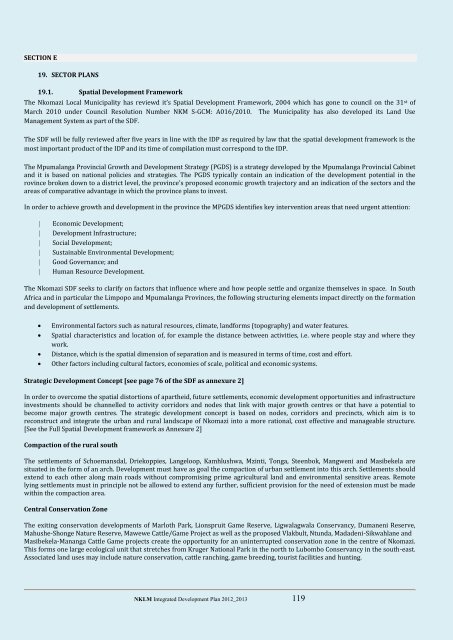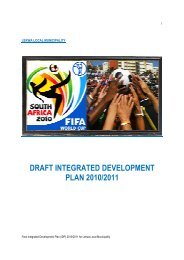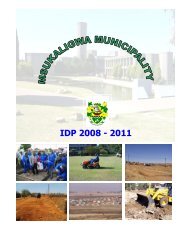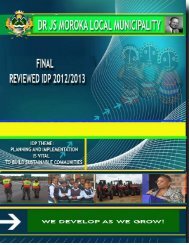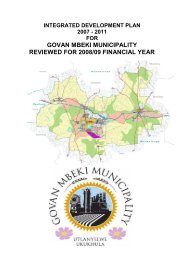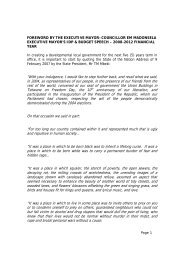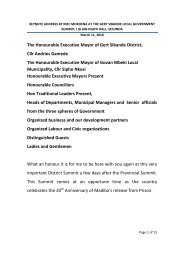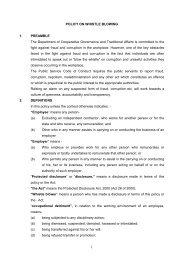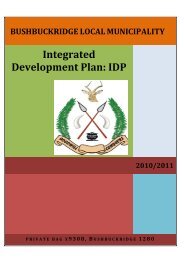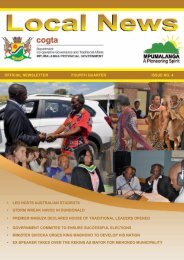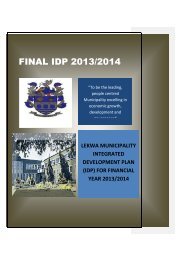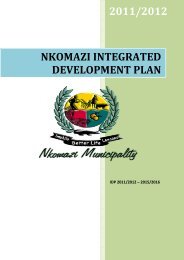Nkomazi Local Municipality 20 - Co-operative Governance and ...
Nkomazi Local Municipality 20 - Co-operative Governance and ...
Nkomazi Local Municipality 20 - Co-operative Governance and ...
- No tags were found...
Create successful ePaper yourself
Turn your PDF publications into a flip-book with our unique Google optimized e-Paper software.
SECTION E19. SECTOR PLANS19.1. Spatial Development FrameworkThe <strong>Nkomazi</strong> <strong>Local</strong> <strong>Municipality</strong> has reviewd it’s Spatial Development Framework, <strong>20</strong>04 which has gone to council on the 31 st ofMarch <strong>20</strong>10 under <strong>Co</strong>uncil Resolution Number NKM S-GCM: A016/<strong>20</strong>10. The <strong>Municipality</strong> has also developed its L<strong>and</strong> UseManagement System as part of the SDF.The SDF will be fully reviewed after five years in line with the IDP as required by law that the spatial development framework is themost important product of the IDP <strong>and</strong> its time of compilation must correspond to the IDP.The Mpumalanga Provincial Growth <strong>and</strong> Development Strategy (PGDS) is a strategy developed by the Mpumalanga Provincial Cabinet<strong>and</strong> it is based on national policies <strong>and</strong> strategies. The PGDS typically contain an indication of the development potential in therovince broken down to a district level, the province's proposed economic growth trajectory <strong>and</strong> an indication of the sectors <strong>and</strong> theareas of comparative advantage in which the province plans to invest.In order to achieve growth <strong>and</strong> development in the province the MPGDS identifies key intervention areas that need urgent attention:Economic Development;Development Infrastructure;Social Development;Sustainable Environmental Development;Good <strong>Governance</strong>; <strong>and</strong>Human Resource Development.The <strong>Nkomazi</strong> SDF seeks to clarify on factors that influence where <strong>and</strong> how people settle <strong>and</strong> organize themselves in space. In SouthAfrica <strong>and</strong> in particular the Limpopo <strong>and</strong> Mpumalanga Provinces, the following structuring elements impact directly on the formation<strong>and</strong> development of settlements.Environmental factors such as natural resources, climate, l<strong>and</strong>forms (topography) <strong>and</strong> water features.Spatial characteristics <strong>and</strong> location of, for example the distance between activities, i.e. where people stay <strong>and</strong> where theywork.Distance, which is the spatial dimension of separation <strong>and</strong> is measured in terms of time, cost <strong>and</strong> effort.Other factors including cultural factors, economies of scale, political <strong>and</strong> economic systems.Strategic Development <strong>Co</strong>ncept [see page 76 of the SDF as annexure 2]In order to overcome the spatial distortions of apartheid, future settlements, economic development opportunities <strong>and</strong> infrastructureinvestments should be channelled to activity corridors <strong>and</strong> nodes that link with major growth centres or that have a potential tobecome major growth centres. The strategic development concept is based on nodes, corridors <strong>and</strong> precincts, which aim is toreconstruct <strong>and</strong> integrate the urban <strong>and</strong> rural l<strong>and</strong>scape of <strong>Nkomazi</strong> into a more rational, cost effective <strong>and</strong> manageable structure.[See the Full Spatial Development framework as Annexure 2]<strong>Co</strong>mpaction of the rural southThe settlements of Schoemansdal, Driekoppies, Langeloop, Kamhlushwa, Mzinti, Tonga, Steenbok, Mangweni <strong>and</strong> Masibekela aresituated in the form of an arch. Development must have as goal the compaction of urban settlement into this arch. Settlements shouldextend to each other along main roads without compromising prime agricultural l<strong>and</strong> <strong>and</strong> environmental sensitive areas. Remotelying settlements must in principle not be allowed to extend any further, sufficient provision for the need of extension must be madewithin the compaction area.Central <strong>Co</strong>nservation ZoneThe exiting conservation developments of Marloth Park, Lionspruit Game Reserve, Ligwalagwala <strong>Co</strong>nservancy, Dumaneni Reserve,Mahushe-Shonge Nature Reserve, Mawewe Cattle/Game Project as well as the proposed Vlakbult, Ntunda, Madadeni-Sikwahlane <strong>and</strong>Masibekela-Mananga Cattle Game projects create the opportunity for an uninterrupted conservation zone in the centre of <strong>Nkomazi</strong>.This forms one large ecological unit that stretches from Kruger National Park in the north to Lubombo <strong>Co</strong>nservancy in the south-east.Associated l<strong>and</strong> uses may include nature conservation, cattle ranching, game breeding, tourist facilities <strong>and</strong> hunting.NKLM Integrated Development Plan <strong>20</strong>12_<strong>20</strong>13 119


